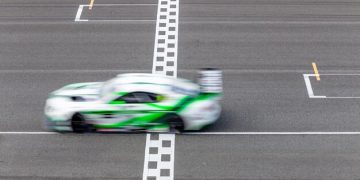NASCAR Next Gen Car: Safety, Performance, and Two Season Analysis

The NASCAR Next Gen car signifies a transformative leap in stock car racing, introducing a standardized chassis, enhanced safety features, and redefined aerodynamic packages, all aimed at improving competition and driver protection through two seasons of rigorous on-track analysis.
The introduction of the NASCAR Next Gen Car: Safety Improvements and Performance Analysis After Two Seasons has been a pivotal moment in stock car racing. From its inception, the car promised a new era for the sport, focusing heavily on enhanced safety and fostering closer competition. As we pass the two-season mark, a comprehensive look at how these ambitious goals have translated from blueprint to asphalt is warranted, examining both the intended benefits and the unforeseen challenges.
The Genesis and Design Philosophy of the Next Gen Car
The development of the NASCAR Next Gen car was a monumental undertaking, driven by a desire to modernize the sport while addressing critical areas like cost efficiency, driver safety, and on-track excitement. This section delves into the foundational principles that guided its creation, emphasizing the shift towards a more standardized and adaptable vehicle platform.
NASCAR initiated the Next Gen project with a clear vision: to create a car that was more relevant to production cars, more cost-effective for teams, and inherently safer for drivers. The car debuted in the 2022 season, marking a radical departure from its predecessors. It incorporated a raft of new technologies and design methodologies aimed at future-proofing the sport.
Modular Design and Component Standardization
One of the core tenets of the Next Gen car’s design is its modularity, a significant departure from the previous generation’s custom-built components. This approach aimed to reduce manufacturing costs for teams and level the playing field, making racing more accessible. Central to this is the universal chassis and common parts. The shift allows for teams to purchase parts from single-source suppliers or approved vendors, promoting uniformity and potentially reducing instances of ‘aero wars’ that inflated budgets.
- Single-source Chassis: Provided by Dallara, ensuring structural consistency across all teams.
- Common Components: Wheels, transaxle, digital dash, and suspension parts are standardized.
- Reduced R&D Costs: Teams can allocate resources more efficiently, focusing on tuning rather than fundamental part design.
- Enhanced Maintainability: Simpler component replacement enhances efficiency during race weekends.
The intention behind this standardization was not merely economic. It was also deeply intertwined with safety. By controlling the manufacturing process of critical components, NASCAR aimed to ensure a consistent level of quality and crashworthiness across the entire field. This holistic approach sought to elevate the baseline safety standards for every car on the track, a move that resonated positively with drivers and crew members.
Ultimately, the genesis of the Next Gen car was a blend of ambition and necessity. It represented NASCAR’s commitment to evolving with the times, embracing technological advancements, and prioritizing the well-being of its athletes, all while striving to deliver a compelling product for fans. This foundational shift sets the stage for a deeper dive into its safety improvements and performance dynamics.
Significant Safety Improvements: A Detailed Examination
Safety has always been a paramount concern in motorsports, and the NASCAR Next Gen car represents the sport’s most concerted effort yet to enhance driver protection. After two seasons, it’s crucial to analyze how these new safety measures have performed under real-world racing conditions, focusing on structural integrity and crash energy management.
The Next Gen car was engineered from the ground up with a renewed emphasis on driver safety, learning lessons from decades of on-track incidents. The design incorporated several innovations aimed at mitigating impact forces and protecting the driver’s compartment. This was a critical area of focus, especially given the high speeds and close-quarters racing inherent to NASCAR.
Structural Enhancements and Energy Absorption Zones
A key area of improvement lies in the car’s updated chassis and body structure. Unlike previous models, the Next Gen car features a symmetrical chassis, improving crash performance from all angles. The redesign includes strategic crumple zones and optimized load paths designed to dissipate crash energy away from the driver’s cockpit. This advanced energy absorption is a stark contrast to older designs where the car absorbed less energy, transferring more of it to the driver.
- Symmetrical Chassis: Better protection in side, front, and rear impacts.
- New Front and Rear Clips: Designed to deform predictably, absorbing significant energy.
- Integrated Side Intrusion Plates: Reinforcing the critical side impact zones.
- Advanced Substructure: Enhanced rigidity around the driver’s feet and legs.
The driver’s seat and restraints have also seen significant upgrades, working in tandem with the car’s structure to minimize injury. The seat is more integrated into the chassis, providing a firmer connection for energy transfer, rather than allowing the driver to rebound. Additionally, the new energy-absorbing foam in critical areas provides an extra layer of protection. This holistic approach ensures that the car functions as a complete safety system, with each component playing a vital role in driver protection.
Analyzing incidents over the past two seasons has shown the effectiveness of these measures. While high-speed impacts are an undeniable part of racing, the anecdotal and quantifiable data suggest that the Next Gen car has performed as intended, often allowing drivers to walk away from significant crashes with fewer and less severe injuries. This ongoing evaluation remains critical as NASCAR continues to refine and improve its safety protocols, using real-world data to drive further innovations.

Performance Analysis: Speed, Aerodynamics, and Competition Dynamics
Beyond safety, the performance aspect of the NASCAR Next Gen car holds immense significance for the sport’s competitiveness and spectacle. After two full seasons, an in-depth analysis of its speed, aerodynamic characteristics, and how these factors have shaped the racing product is essential to understand its true impact.
Upon its debut, the Next Gen car was expected to alter the racing dynamics considerably. Its design incorporated new aerodynamic principles and a shift to a sequential transaxle, among other changes, all intended to create a more relevant and exciting on-track product. These changes have indeed brought about a different style of racing, eliciting varied responses from drivers and fans alike.
Aerodynamic Considerations and Performance on Different Track Types
The Next Gen car features a composite body, a rear diffuser, and an independent rear suspension, all of which contribute to a unique aerodynamic profile. The diffuser, in particular, was a major departure, designed to produce more downforce through ground effects rather than traditional spoilers. This was intended to reduce the reliance on dirty air effects, theoretically allowing cars to follow each other more closely and facilitating more passes.
However, the actual on-track performance has been a subject of continuous adjustment. On superspeedways, the car has demonstrated incredible stability and speed in packs, often leading to thrilling finishes. On intermediate tracks, the initial feedback suggested challenges with tire wear and dirty air, prompting NASCAR to make various aerodynamic adjustments throughout the first two seasons to optimize the racing. Short tracks, too, have seen different dynamics, with the car’s increased mechanical grip demanding a different driving style.
The shift to a sequential transaxle and a single lug wheel nut system also played a role in performance. The sequential transaxle allows for faster, more precise gear changes, which has seen lap times improve in certain scenarios. The single lug nut, while simplifying pit stops, also introduced new strategic elements as teams adapted to the faster process. The car’s stiffer suspension package has also been a point of discussion, requiring drivers to adapt their techniques to manage tire grip and car handling.
Overall, the performance analysis reveals a car that is still evolving. While it has delivered on its promise of increased speeds and some closer racing moments, there’s an ongoing effort to fine-tune its aerodynamic package and mechanical grip to ensure it consistently provides the best possible racing product across all track configurations. This iterative process is a testament to NASCAR’s commitment to optimizing the Next Gen car’s potential.
Driver Feedback and Adaptation Challenges
The transition to any new racing platform inevitably presents a significant learning curve for drivers, and the NASCAR Next Gen car has been no exception. Understanding the feedback from drivers and how they’ve adapted to the car over two seasons provides crucial insights into its characteristics and the challenges it poses.
From the outset, drivers noted the distinctly different feel of the Next Gen car compared to its predecessors. Its stiffer chassis, independent rear suspension, and reliance on new aerodynamic principles demanded a recalibration of driving styles and a deeper understanding of its behavior under various conditions. This adaptation period has been a critical aspect of the car’s initial years on track.
Adjusting to New Dynamics and Braking Characteristics
A primary area of adjustment for drivers has been the car’s braking system and overall handling. The Next Gen car features larger brakes and a significantly stiffer suspension, providing more mechanical grip but also requiring more precise input. Drivers have emphasized the need for a different approach to corner entry and exit, often leading to a more aggressive, yet controlled, driving style.
- Larger Carbon Brakes: Improved stopping power, but also presented challenges with brake fade management.
- Stiffer Suspension: Enhanced cornering ability but less forgiving over bumps and aggressive curbs.
- New Tire Compound: Required drivers to manage tire degradation differently, impacting long runs.
- Increased Sensitivity to Setup: Small changes in car setup have a more pronounced effect on handling.
Interviews with prominent drivers reveal a divided opinion on the car. Some praise its increased stability and the potential for closer racing, while others have expressed concerns about the car’s rigidity and the impacts, particularly during short track races. The car’s rear-end characteristics, influenced by the diffuser, also required a period of adjustment. Drivers needed to learn how to manipulate the aerodynamics effectively, both in clean air and in traffic, to maintain optimal performance.
Furthermore, the increased physical demand of driving the Next Gen car has been noted. Its stiff nature translates more road imperfections and impact forces directly to the driver, necessitating increased physical conditioning. This ongoing dialogue between NASCAR, teams, and drivers highlights a commitment to continuous improvement, ensuring that the car evolves in a way that prioritizes both competition and driver well-being. The anecdotal evidence gathered from two seasons of intense racing forms the basis for future modifications and refinements.
Cost Efficiency and Sustainability in the Next Gen Era
One of the foundational pillars of the NASCAR Next Gen car project was a commitment to significantly improve the sport’s cost efficiency and promote greater sustainability. After two seasons, it is pertinent to evaluate whether these economic and environmental objectives have been met, and what impact they’ve had on team operations and the broader racing ecosystem.
The spiraling costs of racing had become a major concern for team owners, potentially limiting new entries and threatening the long-term viability of the sport. The Next Gen car was designed to standardize components, reduce development expenses, and foster a more level financial playing field, while also embracing more sustainable practices.
Financial Implications for Teams and Long-Term Goals
The modular design and common component suppliers were central to the cost-saving strategy. Teams no longer had to invest heavily in designing and manufacturing every single part, allowing them to focus resources on race preparation, engineering talent, and driver development. While initial startup costs were high due to the acquisition of new cars and equipment, the long-term aim was a noticeable reduction in operational expenses.
- Reduced R&D Spending: Teams save on designing specific parts, focusing instead on setup and strategy.
- Standardized Parts: Lower acquisition costs for components due to mass production and controlled supply chain.
- Simplified Repair Process: Easier and quicker replacement of damaged modules reduces downtime and repair expenses.
- Potential for New Team Entries: Lower barriers to entry might attract new investors and organizations to the sport.
Beyond cost efficiency, sustainability was also woven into the Next Gen car’s philosophy. The car’s composite body panels are more durable and easily replaceable, reducing waste. There’s also an ongoing effort to explore more sustainable fuel options and operational practices across the sport. While these environmental initiatives are a longer-term endeavor, the Next Gen car design inherently supports a more resource-efficient model through its standardized and recyclable components.
However, the transition has not been without its financial challenges. Some smaller teams initially struggled with the upfront investment required for the new fleet of cars and parts. The continuous adjustments to the car’s setup and components by NASCAR also presented unexpected costs as teams had to adapt. Despite these initial hurdles, the general consensus points towards a more financially stable future for teams, provided the standardization process continues to mature and unexpected changes are minimized. The long-term vision of a more sustainable and economically balanced sport remains a core objective of the Next Gen project.

The Evolution of Racing: Fan Experience and Future Outlook
The NASCAR Next Gen car was not just about safety and cost; it was also meticulously designed to enhance the fan experience and secure the sport’s future appeal. After two seasons, examining how the car has impacted race excitement, viewership, and the overall fan engagement provides crucial insights into its success and where the sport is headed.
NASCAR aimed to produce a car that encouraged closer racing, more passing opportunities, and a more visually appealing product. The aesthetics of the Next Gen car, with its more aggressive stance and wheel design, were intended to resonate more closely with modern production cars, making it more relatable for the automotive enthusiast. This blend of performance and visual appeal was key to reinvigorating fan interest.
Impact on On-Track Product and Engagement
Initial assessments of the Next Gen car’s impact on racing have been mixed but largely positive. On certain track configurations, particularly superspeedways, the car has delivered some of the most competitive and thrilling finishes in recent memory. The ability of cars to draft more effectively and remain in tighter packs has led to increased lead changes and dramatic final laps, a definite win for fan engagement.
However, on other track types, particularly short tracks and road courses, the car’s stiff nature and reliance on specific aerodynamic packages initially led to some challenges with passing and tire wear. NASCAR has shown a commendable willingness to make in-season adjustments to address these issues, demonstrating a commitment to optimizing the racing product based on real-world feedback. This iterative approach is vital for the sport’s long-term health.
The visual aspect of the car, with its larger wheels and a cleaner body, has also been well-received by many. The single lug nut pit stops, while sometimes challenging for crews, have added a new element of excitement and speed to the pit lane action. From a merchandising perspective, the increased relevance to street cars has also opened up new avenues for fan engagement and product sales.
Looking ahead, the Next Gen car is more than just a race vehicle; it’s a platform for future innovation. As NASCAR continues to explore new technologies, from hybrid powertrains to advanced telemetry, the modular design of the Next Gen car positions it well to integrate these advancements. This adaptability is crucial for the sport to remain relevant and exciting in an ever-evolving world of automotive technology. The long-term vision for the Next Gen car is to be a cornerstone of NASCAR’s growth, balancing tradition with progressive advancements.
Challenges and Continuous Improvement Ahead
Despite the significant strides made by the NASCAR Next Gen car in terms of safety and performance, its initial two seasons have also highlighted areas for continuous improvement. No revolutionary design is without its challenges, and addressing these will be critical for the car’s long-term success and ultimate legacy in the sport.
The journey of the Next Gen car is an ongoing process of refinement, adaptation, and learning. While many of its intended benefits have materialized, certain aspects require further attention to ensure the car reaches its full potential for both competitors and fans. This section delves into some of the notable challenges and the proactive steps being taken to address them.
Addressing Residual Concerns and Future Developments
One of the primary challenges has been the car’s rigidity and the impact forces transmitted to drivers, particularly during high-speed impacts or direct hits to the rear. Despite extensive safety features, some drivers have reported feeling the impacts more acutely than in previous generations. NASCAR has responded by incorporating additional energy-absorbing materials and conducting further impact tests to mitigate these forces, demonstrating a commitment to continuous driver safety enhancements.
- Impact Rigidity: Ongoing research into softer rear clips and energy-absorbing structures.
- Tire Performance: Collaborations with Goodyear to develop compounds that provide consistent grip and reduce dirty air effects.
- Aerodynamic Balance: Adjusting the underbody and diffuser to promote closer racing on all track types.
- Component Reliability: Monitoring and improving the durability of standardized parts over prolonged use.
Another area of focus involves fine-tuning the car’s aerodynamic package across different track configurations. While the Next Gen car excels on superspeedways, there’s a collective effort to optimize its performance on intermediate and short tracks to foster even more competitive racing. This includes adjustments to the rear spoiler, underbody strakes, and overall downforce levels, all aimed at creating more passing opportunities and reducing the impact of ‘dirty air’.
The reliability of some standardized components has also been a minor hurdle, with occasional mechanical issues emerging. NASCAR and its suppliers are continuously working to enhance the durability and longevity of these parts, ensuring consistency and reducing unforeseen failures. This process involves thorough data analysis from race weekends and off-season testing, leading to iterative improvements in design and manufacturing.
Ultimately, the Next Gen car is a living, evolving entity. The willingness of NASCAR, teams, and manufacturers to listen to feedback, implement changes, and constantly push the boundaries of technology is what will define its legacy. The path forward is one of continuous refinement, aiming to create a racing machine that is both exhilaratingly fast and uncompromisingly safe, securing NASCAR’s position at the forefront of motorsports innovation.
| Key Point | Brief Description |
|---|---|
| ✅ Safety Enhancements | Features symmetrical chassis, enhanced crumple zones, and integrated side intrusion plates for superior driver protection in various impacts. |
| 🚀 Performance Output | Introduced a sequential transaxle and rear diffuser, aiming for closer racing and more stable aerodymanics; still undergoing adjustments for optimal balance. |
| 💡 Cost Efficiency | Modular design and standardized components reduce team R&D and operational costs, promoting long-term financial sustainability for owners. |
| 🔄 Driver Adaptation | Drivers have adjusted to stiffer suspension, larger brakes, and new tire dynamics, requiring nuanced driving techniques and physical conditioning. |
Frequently Asked Questions About the NASCAR Next Gen Car
The Next Gen car features a symmetrical chassis, enhanced energy-absorbing crumple zones, and integrated side intrusion plates. These innovations are designed to distribute crash forces more effectively, reducing the impact on the driver and significantly enhancing overall safety during high-speed incidents on the track.
It introduced a sequential transaxle and a rear diffuser, aiming for closer racing by reducing dirty air effects. While it has led to more competitive finishes on superspeedways, NASCAR continually adjusts aerodynamics to optimize its performance and facilitate passing on intermediate and short tracks for overall enhanced competition.
Yes, the modular design and standardized components significantly reduce research and development costs for teams. While initial investments were high, the long-term goal is to make racing more financially sustainable by lowering operational expenses and potentially attracting new team owners, improving the sport’s economic health.
Drivers have had to adapt to a stiffer chassis, larger carbon brakes, and new tire compounds, requiring more precise inputs and different techniques for managing tire wear. Some also noted increased impact rigidity in crashes, prompting NASCAR to make ongoing structural refinements based on driver feedback.
The Next Gen car is an evolving platform, with NASCAR committed to continuous improvement in safety, performance, and sustainability. Future developments will focus on refining aerodynamics for all track types, enhancing component reliability, and potentially integrating new technologies like hybrid powertrains to keep the sport at the forefront of motorsports innovation.
Conclusion
The NASCAR Next Gen car, after two full seasons on track, has unequivocally ushered in a transformative era for stock car racing. Its ambitious design, centered on enhanced safety, cost efficiency, and improved competition, has largely delivered on its promises, albeit with an ongoing process of refinement. While challenges remain in perfecting its aerodynamic balance and mitigating some impact forces, the commitment from NASCAR, teams, and manufacturers to continuous improvement is evident. The Next Gen car stands as a testament to the sport’s willingness to evolve, blending tradition with modern engineering to safeguard its drivers, optimize financial stability for its participants, and, most importantly, deliver a thrilling and engaging experience for its passionate fanbase for years to come.





